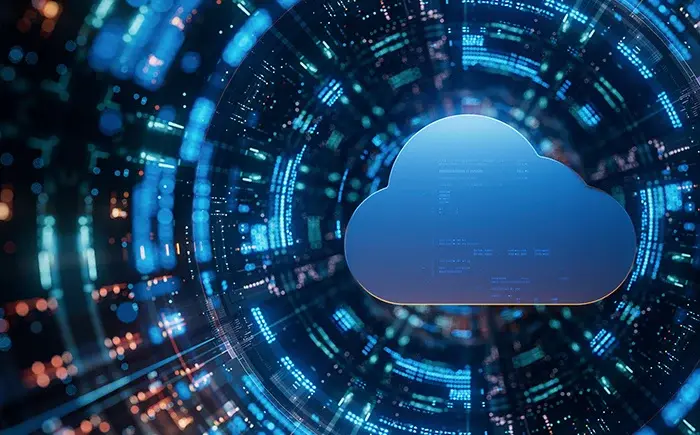- Blog
- The ultimate list of digital transformation statistics
The ultimate list of digital transformation statistics

With improved technology and modern tools making the world smaller than ever, there has never been a more important time to have a clear and concise DX strategy to ensure your organisation is not left behind. For proof, look no further than an IDG Research business impact survey that showed 59% of 373 IT decision makers were accelerating their digital transformation efforts due to pressures arising from the pandemic1.
In the words of MIT principal research scientist George Westerman: “Digital transformation marks a radical rethinking of how an organisation uses technology, people and processes to fundamentally change business performance2”. It is not merely digitisation or technological upgrades but an all-encompassing “conglomeration of man, machine and metrics3” that can deliver wholesale change to the way an organisation does business.
Research, insight and advice company HFS has also identified that the day is fast approaching when automation and digital technology are no longer talked about so much as the critical “value levers” for operations but as “an embedded part of the fabric of the future operations platform for new generation enterprises4”. It envisages a digital OneOffice paradigm that is all about creating the digital customer experience and an intelligent, single office to enable and support it.
According to data researcher IDC, global spending on digital transformation technologies and services was set to grow 10.4% into $1.3 trillion5. While slower than the 17.9% growth of the previous year6, it’s clear that even in a pandemic environment of cost-cutting and budget concerns, spending on digital tools remains a priority for smart organisations - and so it should.
Still need convincing?
Well, you’ve come to the right place because we’ve compiled the ultimate list of digital transformation statistics from a variety of trusted sources that will leave you in no doubt that embracing the future today is imperative for any business looking to survive, let alone thrive, in the post-pandemic world.
DIGITAL SOLUTIONS
It goes without saying that COVID-19 has upended the global economy and digital transformation technology investment has not gone unscathed. However, as IDC senior research manager Craig Simpson highlights: “So far it has been affected to a lesser extent since many large-scale DX projects underway or planned are instrumental to broader strategic business initiatives7.”
As shown in the below graph, despite DX growth rates falling in the wake of COVID-19, strong investment opportunities continue across most industries, with the public sector, financial services and infrastructure among those to maintain double-digit growth rates in their bid to deliver exceptional customer experience
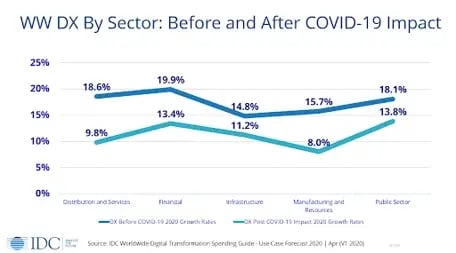
Where once enterprises were mere consumers of technology, these days they are becoming big-time producers as evidenced by the likes of Walmart, which is now the third largest purchaser of technology behind Alphabet and Amazon and offers its own distribution system. Similarly, Goldman Sachs is providing its own APIs that other companies can build on.
This rush to pursue digital transformation has seen IDC predict that 52% of global GDP will be driven by “digitally transformed” enterprises by 2023 and that within another year, 51% of IT budgets will be focused on digital innovation and transformation8.
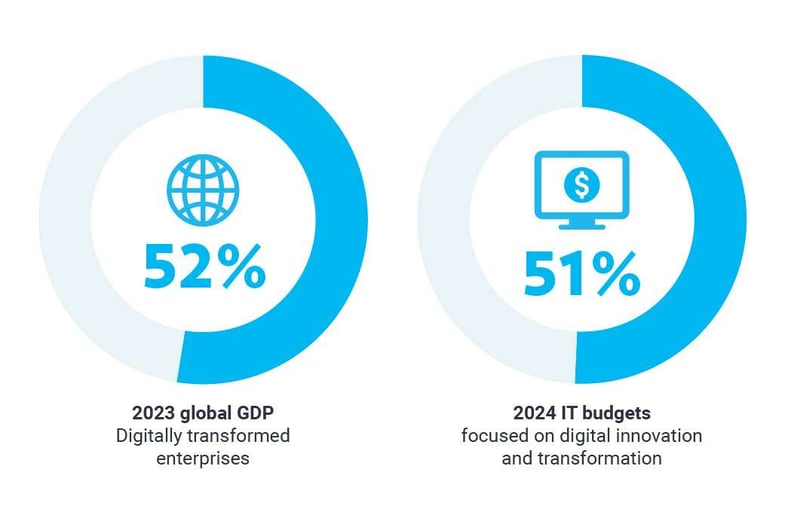
EMBRACING THE CLOUD

One of the biggest digital transformation drivers in 2021 is the move to the cloud. While traditional data centres have long been the home of tech infrastructure, companies are now looking to the cloud and into edge devices. This is all the more so after the pandemic forced IT leaders to reprioritise their strategies to adopt cloud software for video collaboration and build apps to ensure their workforces could fulfil their duties in a world of digital integration, social distancing and contact tracing.
Disruptions to supply chains and access to bricks-and-mortar stores has also forced many companies to rethink their approach to ecommerce and the machine learning software behind it.
According to IDC, there are 38 billion connected ‘things’ in 2021 but the 39,000 core data centres are too few and too far away to support all of them9. The need to scale and extend society’s ‘digital reach’ is tipped to drive a ‘renaissance’ in enterprise infrastructure as distributed ‘cloud systems’ at the edge and near-edge are installed.
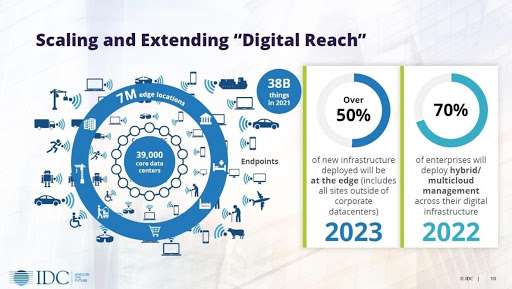
IDC expects 70% of enterprises will deploy hybrid/multi-cloud management across their digital infrastructure by 2022 and that more than half of new infrastructure will be deployed at the edge (including all sites outside of corporate data centres) by 202310. This compares with just 10% in 2019 and will include a mix of fully integrated systems with cloud offerings (such as AWS Outposts) and systems that are more open such as those based on Azure Stack, Red Hat or Google Anthos.
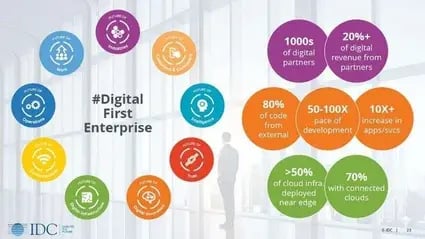
RAPID EXPANSION

With the focus on digital transformation ramping up, IDC chief analyst Frank Gens has highlighted that enterprises are increasingly using agile and DevOps methods of creating and managing software, modular software and democratising development. For evidence of that, consider that only 3% of enterprises were deploying code to production at least once a day in 2019. And what does the future hold? Well, the IDC is predicting that figure will reach 60% by 202511.
Such incredible rates of growth will result in more than 250 million new apps and services being developed and deployed in support of the digital economy by 2024. Remarkably, that will mean the same number of applications are created in four years as have been produced in the past 40 years12.
The digital transformation change sweeping all sectors and regions of business was reinforced in a recent McKinsey Global Survey that targeted almost 900 C-level executives and seniors managers. Studying average rates of digital adoption in recent years, researchers found that since COVID-19 became part of the global lexicon, companies have accelerated the digitisation of their internal operations and customer and supply-chain interactions by three to four years13.

McKinsey’s respondents were also three times more likely now than before the crisis to say at least 80% of their customer interactions were digital in nature. This reinforces that companies and industries have been forced to respond quickly as consumers move dramatically toward online channels. The survey also found the share of digital or digitally enabled products in their portfolios had sped up by an incredible seven years14.
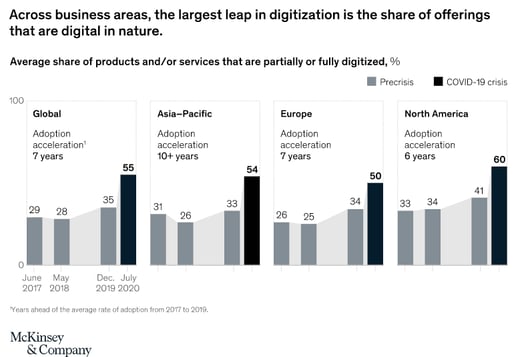
It appears there has also been a significant shift in executive mindsets on the role of technology in business. McKinsey’s 2017 survey showed that almost half of executives considered cost savings as one of the most important priorities in their digital strategies. Fast forward to the post-COVID world and only 10% of executives still hold that view, with almost 70% now focused on digital transformation in a bid to secure a competitive advantage or keep up with their competitors.
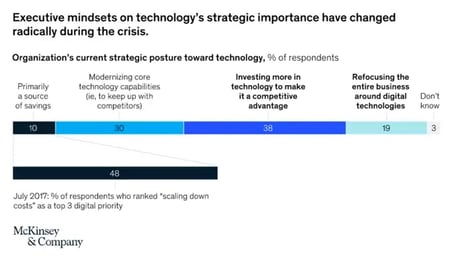
The speed at which companies were able to implement digital change to cope with the pandemic has also likely played a role in giving executives confidence to embrace wider transformation. McKinsey specifically asked respondents how long it took to execute various COVID-related changes and how long it would have taken before the crisis. The response was stunning, with many of the changes playing out 20-25 times faster than expected.
Remote working is a case in point. Respondents said it would have previously taken more than a year to implement the level of remote working that took place during the crisis. However, amid the pressure and urgency of the pandemic, it took an average of 11 days to establish a workable solution and nearly all companies had done so within a few months15.
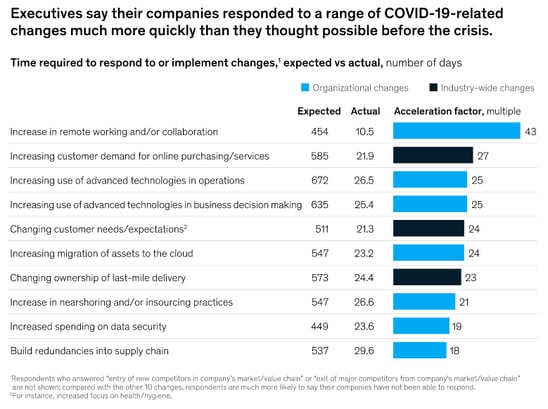
SUMMARY
While there have been countless DX success stories on the back of the global pandemic, there are various reasons why some digital transformation strategies are destined to fail – poor leadership, disconnects between IT and the business, lagging employee engagement and substandard operations. Not to mention one of the key culprits - an overstated focus on cost-cutting as a business driver.
In the modern world, digital transformation is too important to get wrong. Organisations need to ensure their employees feel part of the journey and place a heavy focus on key dimensions for success such as operations, governance and, in particular, talent and culture. It’s all well and good to promote emerging tech and revamped processes but without the right people rolling them out, you are already behind the eight-ball.
Digital transformation has been part of the business landscape for years now. However, the COVID-19 crisis represents a pivotal moment in the way it is perceived. Companies have been forced to roll out change quicker than they planned, consumers have demanded a new way of engaging with businesses and while mistakes may have been made, lessons have also been learned - and that’s just as well because the pace of change is not likely to slow down soon.
THE STATISTICS
Investment in Digital
- Global spending on digital transformation technologies and services in 2020 was set to grow 10.4% to $1.3 trillion
- 52% of global GDP will be driven by “digitally transformed” enterprises by 2023
- 51% of IT budgets will be focused on digital innovation and transformation by 2024
- Only 10% of executives consider cost savings one of the most important priorities in their digital strategies, with almost 70% focused on digital transformation in a bid to secure a competitive advantage or keep up with their competitors
Digital Development
- 70% of enterprises will deploy hybrid/multi-cloud management across their digital infrastructure by 2022
- More than half of new digital infrastructure will be deployed at the edge (including all sites outside of corporate data centres) by 2023
- 60% of enterprises will be deploying code to production at least once a day by 2025 compared to 3% in 2019
- More than 250 million new apps and services are being developed and deployed in support of the digital economy by 2024, meaning the same number of applications will be created in four years as the past 40 years
The COVID Effect
- 59% of 373 IT decision makers were accelerating their digital transformation efforts due to pressures arising from the pandemic
- Despite DX growth rates falling in the wake of COVID-19, financial services and infrastructure are among sectors to maintain double-digit growth rates
- Companies have accelerated the digitisation of their internal operations and customer and supply-chain interactions by three to four years since the start of the COVID pandemic
- Companies are three times more likely now than before the COVID pandemic to say at least 80% of their customer interactions are digital in nature
- The share of digital or digitally enabled products in companies portfolios have sped up by seven years since the start of the COVID pandemic
- Executives report many of their digital changes are being executed 20-25 times faster than before the COVID crisis
- It took an average of 11 days for companies to establish a workable solution for remote working during the COVID crisis compared to the process taking more than a year prior to the crisis
Digital Trends
- From 2021 to 2023, overall ICT spending will grow by at least 5% annually due to continued expansion in new technologies while traditional ICT will continue to see growth that tracks GDP
- Within 5-10 years, new technologies such as robotics, artificial intelligence and AR/VR will expand to represent more than 25% of ICT spending
- Over the next five years, all growth in traditional tech spending will be driven by just four platforms - cloud, mobile, social and big data/analytics
- New technologies will soon eclipse $1 trillion in annual revenue, largely due to the rapid growth of IoT in recent years lead by investments in the manufacturing and transportation industries
- Nearly 97% of C-level executives aspire to achieve an OneOffice organisation
- 83% of companies expect to increase their investment in digital technologies in the coming year
1 www.cio.com/article/3211428/what-is-digital-transformation-a-necessary-disruption.html
2 - 3 www.forbesindia.com/article/one-ceo-club/making-digital-transformation-a-success/60429/1
4 www.hfsresearch.com/about/
5 - 7 www.idc.com/getdoc.jsp?containerId=prUS46377220
8 - 12 www.in.pcmag.com/news-analysis/135415/idc-the-digital-first-enterprise-will-be-half-of-the-economy-by-2023-are-you-ready
13 - 15 www.mckinsey.com/business-functions/strategy-and-corporate-finance/our-insights/how-covid-19-has-pushed-companies-over-the-technology-tipping-point-and-transformed-business-forever

